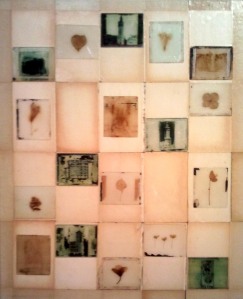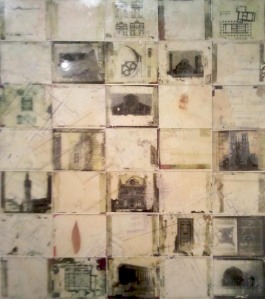Tagged: Mary Ellen Leger
Mary Ellen Leger at the ACA
Mary Ellen Leger
“Braille Series #28”
acrylic, braille pages and printer’s ink tins on wood
on view in the Leger’s solo exhibition “Collages and Constructions” in the Side Gallery of the Acadiana Center for the Arts, 101 W. Vermilion St., Lafayette, LA 70501 until November 5, 2011. To contact the ACA, call 1.337.233.7060.
Leger’s work is concerned with themes of knowledge, information, experience, censorship, consciousness and paradox. All together, the work presents a zen-like face to its viewers that is both challenging and soothing, open yet mysterious, intellectual, yet emotive, and full yet empty. To read a full review of the exhibition, visit the earlier post titled EVERYTHING ZEN.
Mary Ellen Leger at the ACA
Mary Ellen Leger
“Geometry Series # 18”
acrylic, paper, flowers, and glass on canvas
on view in the Leger’s solo exhibition “Collages and Constructions” in the Side Gallery of the Acadiana Center for the Arts, 101 W. Vermilion St., Lafayette, LA 70501 until November 5, 2011. To contact the ACA, call 1.337.233.7060.
Leger’s work is concerned with themes of knowledge, information, experience, censorship, consciousness and paradox. All together, the work presents a zen-like face to its viewers that is both challenging and soothing, open yet mysterious, intellectual, yet emotive, and full yet empty. To read a full review of the exhibition, visit the earlier post titled EVERYTHING ZEN.
Mary Ellen Leger at the ACA
Mary Ellen Leger
“Book Pages #1
acrylic and book pages on canvas
on view in the Leger’s solo exhibition “Collages and Constructions” in the Side Gallery of the Acadiana Center for the Arts, 101 W. Vermilion St., Lafayette, LA 70501 until November 5, 2011. To contact the ACA, call 1.337.233.7060.
Leger’s work is concerned with themes of knowledge, information, experience, censorship, consciousness and paradox. All together, the work presents a zen-like face to its viewers that is both challenging and soothing, open yet mysterious, intellectual, yet emotive, and full yet empty. To read a full review of the exhibition, visit the earlier post titled EVERYTHING ZEN.
Mary Ellen Leger at the ACA
Mary Ellen Leger
detail from “Braille Series #9″
wire, pages of braille, wax and tea bags
on view in the Leger’s solo exhibition “Collages and Constructions” in the Side Gallery of the Acadiana Center for the Arts, 101 W. Vermilion St., Lafayette, LA 70501 until November 5, 2011. To contact the ACA, call 1.337.233.7060.
Leger’s work is concerned with themes of knowledge, information, experience, censorship, consciousness and paradox. All together, the work presents a zen-like face to its viewers that is both challenging and soothing, open yet mysterious, intellectual, yet emotive, and full yet empty. To read a full review of the exhibition, visit the earlier post titled EVERYTHING ZEN.
EVERYTHING ZEN
Mary Ellen Leger
“Geometry Series #26”
acrylic, paper, photo-transparencies, and glass
2002
on view in the Leger’s solo exhibition “Collages and Constructions” in the Side Gallery of the Acadiana Center for the Arts, 101 W. Vermilion St., Lafayette, LA 70501 until November 5, 2011. To contact the ACA, call 1.337.233.7060.
written by Reggie Michael Rodrigue
What follows is a Zen parable:
Nan-in, a Japanese master during the Meiji era (1868-1912), received a university professor who came to inquire about Zen. Nan-in served tea. He poured his visitor’s cup full, and then kept on pouring. The professor watched the overflow until he no longer could restrain himself. “It is overfull. No more will go in!” “Like this cup,” Nan-in said, “you are full of your own opinions and speculations. How can I show you Zen unless you first empty your cup?”
This tension between fullness and emptiness plays out in the work of Lafayette artist Mary Ellen Leger. For me, walking into Leger’s current exhibition “Collages and Constructions” was like walking into a old library that had been turned into a Zen Buddhist monastery. If there was a soundtrack to the exhibition, it would be T.S. Eliot reading “The Love Song of J. Alfred Prufrock” over a low, continuous hum. Add in measures of complete silence and the beeps used on television to censor speech, and something which expresses the feeling of the exhibition comes together.
Leger achieves this tension between fullness and emptiness through the poetic and evocative materials she uses. The “fullness” of the work comes from Leger’s use of old book pages (some written in English, some in braille), pictures of architecture, architectural plans, dried flowers, and used tea bags and ink tins. The book pages represent combined and indexed knowledge. What man has achieved with his knowledge is represented by pictures of architecture and architectural plans. The dried flowers, used tea bags and ink tins represent life lived and experienced directly. All together, these materials speak of the sum total of life itself: the subjective and the objective.
In much of the collages on canvas, Leger lays out grids of book pages across her canvas. These pages set up a visual rhythm within the works that is dependent on the size of the pages and the “look” of printed English or braille. One can read most of the pages through the translucent skin of acrylic which holds them in place. However, I think the best way to “read’ them is as a whole – a system of knowledge. “Reading” the work any other way presents frustrating challenges. Leger has methodically censored some of the pages with black acrylics, suspended tea bags and affixed ink tins. Through these actions, Leger withholds or obscures information from the viewer. It is as if she’s saying to the viewer, “You can know a lot of things, but you will never know it all.” The artist also deploys empty pages from printed books in the works. With these pages, the paradox inherent in the exhibition also plays out. They act as moments of wordless emptiness in the exhibition, yet they seem full with age and experience. In this way, they still impart information. The same can be said of the censored pages.
With this, we reach the crux of Leger’s oeuvre. At its center, it is concerned with man’s relationship to knowledge and experience, and how one must feed the other. Enlightenment (in a very Zen sense) is only arrived at when one realizes that he is already there. In this space, the difference between fullness and emptiness looses it’s footing and simply becomes a matter of perception.
In this respect, another Zen Parable comes to mind:
Once there was a well-know philosopher and scholar who had devoted himself to the study of Zen for many years. On the day that he achieved enlightenment, he took all of his books out into his yard and burned them.
In a way, Leger is doing something similar. However, instead of burning books and transmuting them into ash, she is transmuting her materials into art. Her works are tokens of knowledge gained, experience lived and consciousness explored. Simply by expressing this, the individual works make for great art; yet, they are also very beautiful. Leger has managed to balance her conceptual and aesthetic concerns to the highest degree, creating works that are both visually poetic and blunt.
The whole exhibition, which is composed of works from different series (including some delicate sculptures made of tissue paper, wire, tea bags and acrylic that follow similar lines of thought and aesthetics), is an eloquent presentation of Leger’s work over the past decade, and I highly recommend engagement with the work and the themes they encompass.




